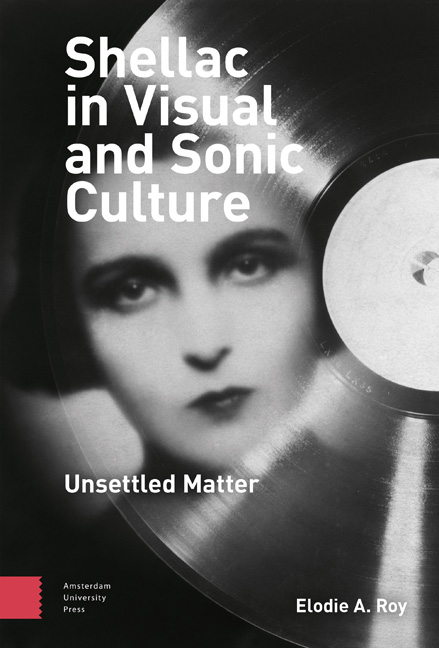Book contents
- Frontmatter
- Contents
- List of illustrations
- Acknowledgements
- Introduction: From material culture to the materials of culture
- 1 Sheen: Early stories and circulation of shellac
- 2 Crackle: Assembling the record
- 3 Mirrors: Phono-fetishism and intersensory visions
- 4 Detonations: Shellac at war
- 5 Shards: Waste, obsolescence, and contemporary remediations
- Conclusion: Sonic sculptures
- Bibliography
- Index
3 - Mirrors: Phono-fetishism and intersensory visions
Published online by Cambridge University Press: 17 February 2024
- Frontmatter
- Contents
- List of illustrations
- Acknowledgements
- Introduction: From material culture to the materials of culture
- 1 Sheen: Early stories and circulation of shellac
- 2 Crackle: Assembling the record
- 3 Mirrors: Phono-fetishism and intersensory visions
- 4 Detonations: Shellac at war
- 5 Shards: Waste, obsolescence, and contemporary remediations
- Conclusion: Sonic sculptures
- Bibliography
- Index
Summary
Abstract:
Chapter 3 surveys the intersensory position of recorded sound in the interwar period – also conceived of as a ‘golden age’ of shellac. It notably does so through recovering the largely forgotten – yet significant – trope of the ‘mirror of the voice’ and surveying how it was materially and discursively interpreted by groups as diverse as theorists, artists and home recordists. The first section discusses the visual phono-fetishism of the interwar period and critically reengages with Adorno's essays on phonography. As a counterpoint, the second part of the chapter attends to the defetishising discourse offered by interwar art and design practices (notably those carried out at the Bauhaus in Weimar).
Keywords: art, design, interwar, Weimar Republic, Bauhaus, phonography
At the turn of the twentieth century, shellac became primarily known and experienced as a material and medium of sound rather than of vision. The sonic and visual realms, however, were still entwined in more ways than one. While the first two chapters of this book scrutinise early trade networks, production and labour practices, this chapter engages with larger themes. It examines phonographic consumption and artistic expressivity in the interwar period, resituating phonography within larger historical debates on materiality and technological modernity. This deliberately broader emphasis also serves an important narrative purpose, mimicking the ways in which shellac became culturally absorbed in the sphere of everyday life between the wars (to the point of becoming invisible). The material momentarily disappears, only to reappear in unforeseen assemblages. I approach interwar phonograph culture as a fluid and multisensory object of study, wavering between the auditory and the visual realm. The interwar period, with its heightened intermediality and theoretical vitality, encourages us to explore the changing and asymmetrical – yet not necessarily conflicting – relationships between different regimes of perception. It notably prompts us to consider the vibrant persistence of vision within auditory knowledge, while evidencing how the frontiers between the sonic and the scopic, rather than being harshly defined, were always already porous and negotiable.
As well as introducing a thematic shift, this chapter also proposes a geographical displacement. Moving away from Anglophone countries to continental Europe, it principally engages with Germany and France where phonographic consumption drastically increased following the introduction of electrical recording in 1925.
- Type
- Chapter
- Information
- Shellac in Visual and Sonic CultureUnsettled Matter, pp. 103 - 138Publisher: Amsterdam University PressPrint publication year: 2023



